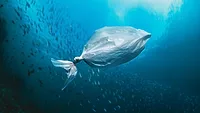More Research Needed on Exposure To, Toxicity of Microplastics in Food

Credit: Karolina Grabowska (karolina-grabowska) via Pexels
There are significant knowledge gaps regarding the presence of nano- and microplastics in foods and their harmful effects on human health, according to a report from the Food and Agriculture Organization of the United Nations (FAO). The document aims to support much-needed future exposure assessments, as well as the development of appropriate legislation and guidance documents on food production, processing, distribution, and consumption in relation to nano- and microplastics contamination.
Despite the dearth of information currently available on the toxicity of nano- and microplastics, FAO urges authorities, stakeholders, and legislative bodies to, where necessary, set limits on human exposure to the substances by implementing precautionary measures. For example, FAO suggests identifying limits for certain food commodities, monitoring the intake of nano- and microplastics through food, and improving the plastic circular economy or increasing the use of biodegradable plastics. FAO also recommends that national regulatory authorities and food safety management stakeholders increase transparency with consumers regarding plastic food packaging, acknowledge the impact of plastic packaging and food-contact materials on the quality of food products, and evaluate and identify entry routes of nano- and microplastics into the human food chain.
At present, the methodologies for sampling, sample preparation, and analysis of microplastics in foods are neither harmonized nor standardized, and there are no common terminologies used in research on the substances. Rectifying the discordance of nano- and microplastics research and reporting is vital to the usability of collected data, according to FAO. The report also outlines knowledge gaps that are in crucial need of addressing:
- The occurrence of microplastics in edible tissues of fish and shellfish
- The contamination of food commodities other than seafood
- The contribution of the inhalation route of exposure to nano- and microplastics
- The composition of plastic packaging materials and the toxicity of their components
- Methodologies for the identification of non-intentionally added substances
- Risk assessment for compounds used in plastic food contact materials
- The biological consequences of nano- and microplastics in organisms.
The report also calls for the development of legislation and food safety guidance documents on nano- and microplastics, which should take into consideration:
- Toxicological dynamics in organisms
- Size-dependent transport, absorption, and accumulation across and in cells and tissues
- No-observed-effect levels (NOELs) and no-observed-adverse-effect levels (NOAELs)
- Estimates of acute and chronic human exposure to different polymers
- Real-life concentration levels
- Interactions and impacts of nano- and microplastics and contaminant mixtures
- Toxicity of various polymer types, shapes, and sizes
- Impact on the gut microbiome
- The effects of food-contact materials’ compositional differences on the release of nano- and microplastics.
The very limited available literature, most of which focuses on fishery products, suggests “considerably low” concentrations of nano- and microplastics in food, the report states. However, some studies have evidenced nano- and microplastics’ ability to move upwards through the food chain, as well as the substances’ presence in marine life where plastic pollution is prevalent.
In its report, FAO was hesitant to draw conclusions on the public health implications of nano- and microplastics due to a dearth of information about the substances’ toxicity and toxic dynamics. From the literature that is available, however, some adverse effects such as the activation and impairment of the immunological system, oxidative stress, and metabolic alterations were observed, albeit in experimental settings where the levels of nano- and microplastics significantly exceeded humans’ real-life exposure.
The report states that, based on the available occurrence and ingestion data, exposure to nano- and microplastics “may not be a significant public health concern” in itself. FAO acknowledges, however, that toxic chemicals may occur in nano- and microplastics, which could migrate into foods and raise health concerns. Further scientific exploration of the subject is necessary to establish the prevalence of toxic chemicals in nano- and microplastics, and the rate that such toxic chemicals may transfer to foods.
Looking for quick answers on food safety topics?
Try Ask FSM, our new smart AI search tool.
Ask FSM →









